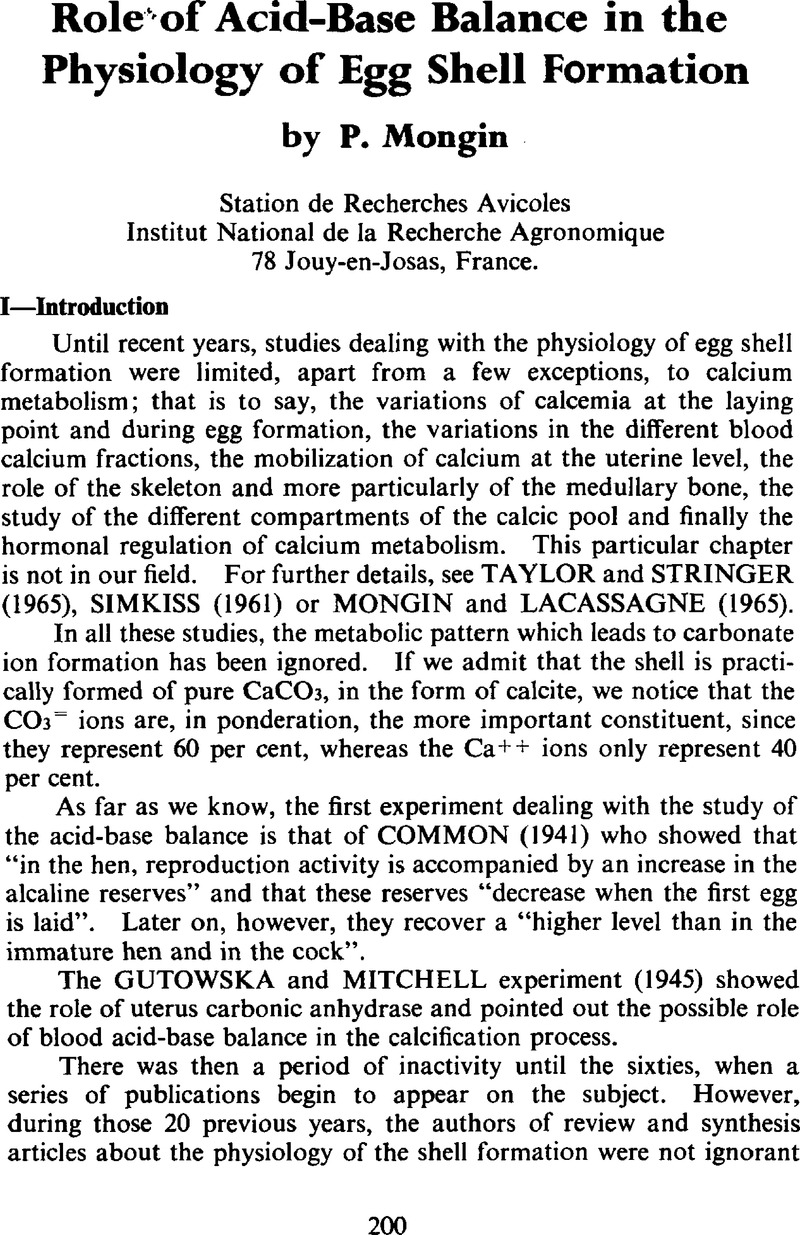Crossref Citations
This article has been cited by the following publications. This list is generated based on data provided by Crossref.
Harrison, P.C.
and
Biellier, H.V.
1969.
Physiological Response of Domestic Fowl to Abrupt Changes of Ambient Air Temperature.
Poultry Science,
Vol. 48,
Issue. 3,
p.
1034.
Snapir, N.
and
Perek, M.
1970.
Distribution of Calcium, Carbonic Anhydrase and Alkaline Phosphatase Activities in the Uterus and Isthmus of Young and Old White Leghorn Hens.
Poultry Science,
Vol. 49,
Issue. 6,
p.
1526.
Schraer, Rosemary
and
Schraer, Harald
1970.
Biological Calcification: Cellular and Molecular Aspects.
p.
347.
Cohen, Israel
Hurwitz, Shmuel
and
Bar, Arie
1972.
Acid-Base Balance and Sodium-to-Chloride Ratio in Diets of Laying Hens.
The Journal of Nutrition,
Vol. 102,
Issue. 1,
p.
1.
Sauveur, B.
and
Mongin, P.
1972.
Contribution a l'etude de l'hypercapnie aigue et chronique chez la poule (Gallus domesticus).
Comparative Biochemistry and Physiology Part A: Physiology,
Vol. 41,
Issue. 4,
p.
869.
Nestor, K.E.
Touchburn, S.P.
Musser, M.A.
and
Naber, E.C.
1972.
Egg Quality and Reproduction in Turkeys..
Poultry Science,
Vol. 51,
Issue. 2,
p.
669.
Nordstrom, Jon O.
1973.
Duration of Egg Formation in Chickens during Heat Stress.
Poultry Science,
Vol. 52,
Issue. 5,
p.
1687.
Mongin, Pierre
and
Mueller, Werner J.
1973.
Normal buffer lines for oxygenated and deoxygenated blood of the laying hen.
Comparative Biochemistry and Physiology Part A: Physiology,
Vol. 44,
Issue. 1,
p.
221.
Smith, A. J.
1974.
Changes in the average weight and shell thickness of eggs produced by hens exposed to high environmental temperatures—A review.
Tropical Animal Health and Production,
Vol. 6,
Issue. 4,
p.
237.
Siegel, H.S.
Drury, L.N.
and
Patterson, W.C.
1974.
Blood Parameters of Broilers Grown in Plastic Coops and on Litter at Two Temperatures.
Poultry Science,
Vol. 53,
Issue. 3,
p.
1016.
Leach, R.M.
1974.
Studies on the Potassium Requirement of the Laying Hen.
The Journal of Nutrition,
Vol. 104,
Issue. 6,
p.
684.
Scott, M.L.
Zimmermann, J.R.
Marinsky, Susan
Mullenhoff, P.A.
Rumsey, G.L.
and
Rice, R.W.
1975.
Effects of PCBs, DDT, and Mercury Compounds upon Egg Production, Hatchability and Shell Quality in Chickens and Japanese Quail.
Poultry Science,
Vol. 54,
Issue. 2,
p.
350.
Miller, P.C.
and
Sunde, M.L.
1975.
The Effects of Precise Constant and Cyclic Environments on Shell Quality and Other Lay Performance Factors With Leghorn Pullets.
Poultry Science,
Vol. 54,
Issue. 1,
p.
36.
Garlich, J.D.
James, R.L.
and
Ward, J.B.
1975.
Effects of Short Term Phosphorus Deprivation on Laying Hens ,.
Poultry Science,
Vol. 54,
Issue. 4,
p.
1193.
Kohne, H.J.
and
Jones, J.E.
1975.
Acid-Base Balance, Plasma Electrolytes and Production Performance of Adult Turkey Hens under Conditions of Increasing Ambient Temperature.
Poultry Science,
Vol. 54,
Issue. 6,
p.
2038.
Premovich, M.S.
and
Chiasson, R.B.
1976.
Reproductive Tissue Activity in Hypothyroid or Heat Stressed Hens.
Poultry Science,
Vol. 55,
Issue. 3,
p.
906.
Sturkie, P. D.
and
Mueller, W. J.
1976.
Avian Physiology.
p.
302.
Mongin, P.
and
Carter, N. W.
1977.
Studies on the avian shell gland during egg formation: Aqueous and electrolytic composition of the mucosa1.
British Poultry Science,
Vol. 18,
Issue. 3,
p.
339.
Pearson, T W
Pryor, T J
and
Goldner, A M
1977.
Calcium transport across avian uterus. III. Comparison of laying and nonlaying birds..
American Journal of Physiology-Endocrinology and Metabolism,
Vol. 232,
Issue. 4,
p.
E437.
Mongin, P.
and
Carter, N. W.
1978.
Studies on the avian shell gland during egg formation: Mucosal intracellularPH1.
British Poultry Science,
Vol. 19,
Issue. 1,
p.
93.



